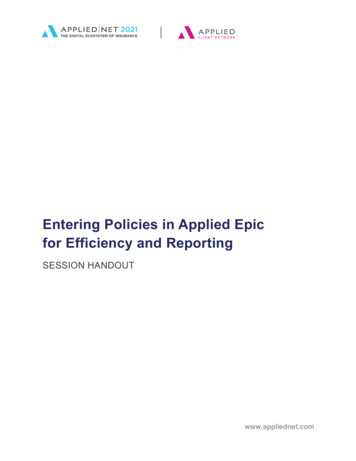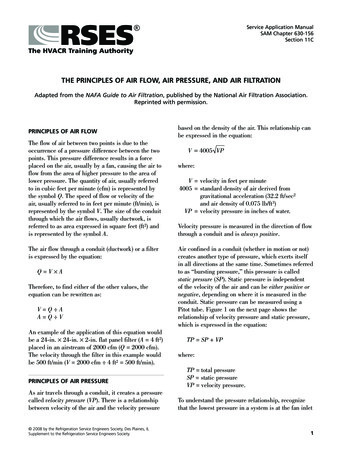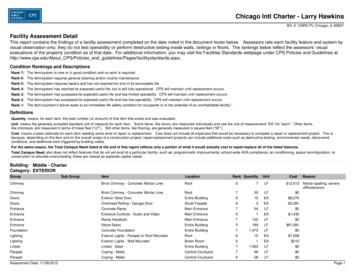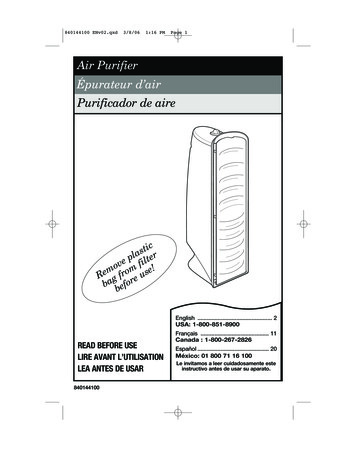
Transcription
AIRIssue No. 2 June 2016Applied Innovation ReviewAppliedInnovationReviewIssue No. 2June 20161
Applied Innovation ReviewIssue No. 2 June 2016BlockChain Technology: Beyond BitcoinAuthors:Michael Crosby (Google)Nachiappan (Yahoo)Pradan Pattanayak (Yahoo)Sanjeev Verma (Samsung Research America)Vignesh Kalyanaraman (Fairchild Semiconductor)6
Applied Innovation ReviewIssue No. 2 June 2016AbstractA blockchain is essentially a distributed database of records, or public ledger of all transactions or digital eventsthat have been executed and shared among participating parties. Each transaction in the public ledger is verifiedby consensus of a majority of the participants in the system. Once entered, information can never be erased. Theblockchain contains a certain and verifiable record of every single transaction ever made. Bitcoin, the decentralized peer-to-peer digital currency, is the most popular example that uses blockchain technology. The digitalcurrency bitcoin itself is highly controversial but the underlying blockchain technology has worked flawlessly andfound wide range of applications in both financial and non-financial world.The main hypothesis is that the blockchain establishes a system of creating a distributed consensus in the digitalonline world. This allows participating entities to know for certain that a digital event happened by creating anirrefutable record in a public ledger. It opens the door for developing a democratic open and scalable digital economy from a centralized one. There are tremendous opportunities in this disruptive technology, and the revolutionin this space has just begun.This white paper describes blockchain technology and some compelling specific applications in both financial andnon-financial sector. We then look at the challenges ahead and business opportunities in this fundamental technology that is all set to revolutionize our digital world.7
Applied Innovation ReviewIntroductionIssue No. 2 June 2016combustion engine that has smart contract among participatingthe potential to transform the entities is met then the parties involved1A blockchain is essentially a distrib- world of finance and beyond . in a contractual agreement can beautomatically made payments as peruted database of records, or publicledger of all transactions or digital Current digital economy is based on the contract in a transparent manner.events that have been executed and the reliance on a certain trusted aushared among participating par- thority. All online transactions rely on Smart Property is another related conties. Each transaction in the public trusting someone to tell us the truth— cept which is regarding controllingledger is verified by consensus of a it can be an email service provider the ownership of a property or asmajority of the participants in the telling us that our email has been set via blockchain using Smart Consystem. Once entered, information delivered; it can be a certification au- tracts. The property can be physicalcan never be erased. The blockchain thority telling us that a certain digital such as car, house or smartphone,contains a certain and verifiable re- certificate is trustworthy; or it can be or it can be non-physical such ascord of every single transaction ever a social network such as Facebook shares of a company. It should bemade. To use a basic analogy, it is telling us that our posts regarding noted here that even Bitcoin is noteasier to steal a cookie from a cook- our life events have been shared only really a currency: Bitcoin is all aboutie jar, kept in a secluded place, than with our friends or it can be a bank controlling the ownership of money.stealing the cookie from a cook- telling us that our money has beenie jar kept in a market place, being delivered reliably to our dear ones in Blockchain technology is findingobserved by thousands of people. a remote country. The fact is that we applications in wide range of arlive our life precariously in the digital eas; both financial and non-financial.Bitcoin is the most popular example world by relying on a third entity forthat is intrinsically tied to blockchain the security and privacy of our digital Financial institutions and banks notechnology. It is also the most con- assets. The fact remains that these longer see blockchain technologytroversial one since it helps to enable third party sources can be hacked, as a threat to traditional businessa multibillion-dollar global market manipulated or compromised. models. The world’s biggest banksare in fact looking for opportunitiesof anonymous transactions withoutany governmental control. Hence it This is where the blockchain tech- in this area by doing research on inhas to deal with a number of regu- nology comes handy. It has the po- novative blockchain applications. Inlatory issues involving national gov- tential to revolutionize the digital a recent interview Rain Lohmus ofernments and financial institutions. world by enabling a distributed con- Estonia’s LHV bank told that theysensus where each and every online found Blockchain to be the mostHowever, Blockchain technology transaction involving digital assets, tested and secure for some bankitself is non-controversial and has past and present, can be verified at ing and finance related applications.worked flawlessly over the years and any time in the future. It does thisis being successfully applied to both without compromising the privacy Non-Financial applications opportufinancial and non-financial world ap- of the digital assets and parties in- nities are also endless. We can enplications. Last year, Marc Andrees- volved. The distributed consensus and vision putting proof of existence ofsen, the doyen of Silicon Valley’s anonymity are two important charac- all legal documents, health records,capitalists, listed the blockchain dis- teristics of blockchain technology. and loyalty payments in the musicindustry, notary, private securitiestributed consensus model as the most imTheadvantagesofBlockchaintechand marriage licenses in the blockportant invention since the Internetitself. Johann Palychata from BNP nology outweigh the regulatory is- chain. By storing the fingerprint ofParibas wrote in the Quintessence sues and technical challenges. One the digital asset instead of storing themagazine that bitcoin’s blockchain, key emerging use case of blockchain digital asset itself, the anonymity orthe software that allows the digital cur- technology involves “smart contracts”. privacy objective can be achieved.rency to function should be consid- Smart contracts are basically comered as an invention like the steam or puter programs that can automati- In this report, we focus on thecally execute the terms of a contract. disruption that every industry inWhen a preconfigured condition in a today’s digital economy is facing due8
Issue No. 2 June 2016Applied Innovation Reviewto the emergence of blockchain technology. Blockchain technology haspotential to become the new engineof growth in digital economy wherewe are increasingly using Internet toconduct digital commerce and shareour personal data and life events.There are tremendous opportunities in this space and the revolutionin this space has just begun. In thisreport we focus on few key applications of Blockchain technologyin the area of Notary, Insurance,private securities and few other interesting non-financial applications.We begin by first describing somehistory and the technology itself.Section I: BlockChainTechnologyAugust 18October 31November 9Domain name“bitcoin.org”registeredBitcoin designpaper publishedBitcoin projectregistered atSourceForge.net20082009January 3January 9January 12Genesis blockestablished at18:15:05 GMTBitcoin v 0.1 releasedand announced onthe cryptographymailing listFirst Bitcoin transaction, in block 170from Satoshi to HalFinneyFigure 1: The History of Bitcoin50 coins. Anyone can install this opensource program and become part ofthe bitcoin peer-to-peer network. Ithas grown in popularity since then.The popularity of the Bitcoin hasnever ceased to increase since then.Moreover, the underlying Block1. Short History of BitcoinChain technology is now finding newIn 2008, an individual (or group) range of applications beyond finance.writing under the name of SatoshiNakamoto published a paper enti- 2. Blockchain Technology:tled “Bitcoin: A Peer-To-Peer Elec- How does it work?tronic Cash System”. This paperdescribed a peer-to-peer version of We explain the concept of the blockthe electronic cash that would allow chain by explaining how Bitcoinonline payments to be sent directly works since it is intrinsically linked tofrom one party to another without the Bitcoin. However, the blockchaingoing through a financial institution. technology is applicable to any digitalBitcoin was the first realization of this asset transaction exchanged online.concept. Now “cryptocurrencies” isthe label that is used to describe all 1. Validate Entriesnetworks and mediums of exchange 2. Safeguard Entriesthat uses cryptography to secure 3. Preserve Historic Recordtransactions-as against those systemswhere the transactions are channeledthrough a centralized trusted entity.Internet commerce is exclusivelytied to the financial institutions serving as the trusted third party whoprocess and mediate any electronic transaction. The role of trustedthird party is to validate, safeguardand preserve transactions. A certainpercentage of fraud is unavoidablein online transactions and that needsmediation by financial transactions.This results in high transaction costs.Bitcoin uses cryptographic proofinstead of the trust-in-the-third-partymechanism for two willing parties toexecute an online transaction overthe Internet. Each transaction isprotected through a digital signature,is sent to the “public key” of thereceiver, and is digitally signed usingthe “private key” of the sender. Inorder to spend money, the owner ofthe cryptocurrency needs to provehis ownership of the “private key”.The author of the first paper wantedto remain anonymous and henceno one knows Satoshi Nakamototo this day. A few months later, anopen source program implementing the new protocol was released,beginning with the Genesis block of Figure 2: Traditional Online Financial Transactions using third trusted party (Banks, PayPal, etc.)19
Issue No. 2 June 2016Applied Innovation ReviewThe entity receiving the digital currency then verifies the digital signature, which implies ownership ofthe corresponding “private key”, byusing the “public key” of the sender on the respective transaction.checking every transaction againstthe spender’s account, or “public key”, that is registered in theledger. This ensures that there issufficient balance in his accountbefore finalizing the transaction.Each transaction is broadcasted toevery node in the Bitcoin networkand is then recorded in a publicledger after verification. Every single transaction needs to be verifiedfor validity before it is recorded inthe public ledger. The verifyingnode needs to ensure two thingsbefore recording any transaction:However, there is question of maintaining the order of these transactions that are broadcasted to everyother node in the Bitcoin peer-topeer network. The transactions donot come in order in which theyare generated, and hence there isa need for a system to make surethat double-spending of the cryptocurrency does not occur. Considering that the transactions are passednode by node through the Bitcoinnetwork, there is no guarantee thatorders in which they are received ata node are the same order in whichthese transactions were generated.The above means that there isa need to develop a mechanism1. Spender owns the cryptocurrency, through the digital signature verification on the transaction.2. Spender has sufficient cryptocurrency in his account, throughchecking every transaction againstthe spender’s account, throughFigure 3: Financial Transactions using the BlockChain Technology210so that the entire Bitcoin networkcan agree regarding the order oftransactions, which is a daunting task in a distributed system.The Bitcoin solved this problem by amechanism that is now popularly knownas Blockchain technology. The Bitcoinsystem orders transactions by placingthem in groups called blocks and thenlinking these blocks through what iscalled Blockchain. The transactionsin one block are considered to havehappened at the same time. Theseblocks are linked to each-other (like achain) in a proper linear, chronological order with every block containing the hash of the previous block.There still remains one more problem: Any node in the network cancollect unconfirmed transactionsand create a block and then broad
Applied Innovation ReviewIssue No. 2 June 2016Figure 4: Double spending due to propagation delays in peer-to-peer network.chain provided it contains an answer to The average effort required is exa very special mathematical problem. ponential in the number of zerobits required but verification proThis is also known as “proof of cess is very simple and can bework”: a node generating a block done by executing a single hash.needs to prove that it has put enoughcomputing resources to solve amathematical puzzle. For instance,a node can be required to find a“nonce” which when hashed withboth transactions and hashes of preBitcoin solves this problem by intro- vious blocks produces a hash withducing a mathematical puzzle: each certain number of leading zeros.block will be accepted in the blockcast it to the rest of the network as asuggestion as to which block shouldbe the next one in the blockchain.How does the network decide whichblock should be next in the blockchain? There can be multiple blockscreated by different nodes at the sametime. One can’t rely on the order sinceblocks can arrive at different ordersat different points in the network.Figure 5: Generation of BlockChain from unordered transactions11
Issue No. 2 June 2016Applied Innovation ReviewFigure 6: Mathematical race to protect transactions - I4This mathematical puzzle is not trivial to solve and the complexity ofthe problem can be adjusted so thaton average it takes ten minutes for anode in the Bitcoin network to makea right guess and generate a block.There is very small probability thatmore than one block will be generated in the system at a given time.The first node, to solve theproblem, broadcasts the blockto the rest of the network.Occasionally, however, more thanone block will be solved at the sametime, leading to several possiblebranches. However, the math neededto be solved is very complicated andhence the blockchain quickly stabilizes: after this, every node is in agreement about the ordering of blocks.The network only accepts the longestblockchain as the valid one. Hence,it is next to impossible for an attacker to introduce a fraudulent transaction since it has not only to generatea block by solving a mathematicalThe nodes donating their com- puzzle, but it also has to race mathputing resources to solve the puz- ematically against the good nodes tozle and generate blocks are called generate all subsequent blocks in or-Figure 7: Mathematical race to protect transactions - II412“miner” nodes” and are financially awarded for their efforts.
Issue No. 2 June 2016Applied Innovation Reviewder for it to make the other nodesin the network accept its transactionand block as the valid one. Thisjob becomes even more difficultsince blocks in the blockchain arelinked cryptographically together.Section II: Existing MarketBlockchain technology is findingapplications in both financial andnon-financial areas that traditionallyrelied on a third trusted online entity to validate and safeguard onlinetransactions of digital assets. Therewas another application “Smart Contracts” that was invented in year 1994by Nick Szabo. It was a great idea toautomatically execute contracts between participating parties. However,it did not find usage until the notionof crypto currencies or programmable payments came into existence.Now the two programs, Blockchainand Smart Contracts can work together to trigger payments when apreprogrammed condition of a contractual agreement is triggered. SmartContracts are really the killer application of the cryptocurrency world.Smart Contracts are contracts whichare automatically enforced by computer protocols. Using blockchaintechnology has made it much moreeasier to register, verify and executethem. Moreover, open source companies like Ethereum and Codiusare already enabling Smart Contracts using blockchain technologyand many companies which operateon bitcoin and blockchain technologies are beginning to support SmartContracts. Many cases where assetsare transferred only after meetingcertain conditions, which requireLawyers to create a contract andBanks to provide Escrow services,can be replaced by Smart Contracts.In particular, Ethereum has createdlot of excitement for its programmable platform capabilities. The company allows anyone to create theirown cryptocurrency and use thatto execute and pay for Smart Contracts, while it also possesses its owncryptocurrency (ether) which is usedto pay for the services. Ethereumis already powering a wide range ofearly applications in areas such asGovernance, autonomous banks,keyless access, crowdfunding, financial derivatives trading and settlement, all by using Smart Contracts.Also, there are a number of blockchains in existence to support awide range of applications besides cryptocurrency. Currentlythere are three approaches in theindustry to support other applications and overcome perceivedlimitations of Bitcoin blockchain:Alternative Blockchains: A system ofusing the blockchain algorithm toachieve distributed consensus ona particular digital asset. The system may share miners with a parentnetwork such as Bitcoin’s, which iscalled merged mining. These Alternative Blockchains have been suggested to implement applicationssuch as DNS, SSL certificationauthority, file storage and voting.Colored Coins: An open sourceprotocol that describes a class ofmethods for developers to create digital assets on top of Bitcoinblockchain by using its functionalities beyond digital currency.Sidechains: Alternative Blockchainswhich are backed by Bitcoins via aBitcoin Contract, just as dollars andpounds used to be backed by Gold.One can possibly have a thousands of Sidechains “pegged”to Bitcoin, all with different characteristics and purposes, and all ofthem taking advantage of the scarcity and resilience guaranteed bythe Bitcoin blockchain. In turn,the Bitcoin blockchain can iterateto support additional features forthese experimental Sidechains, oncethey have been tried and tested.Companies such as IBM, Samsung,Overstock, Amazon, UBS, Citi,Ebay, and Verizon Wireless, toname a few, are all exploring alternative and novel uses of the blockchainfor their own applications. Nine ofthe world’s biggest banks includingBarclays and Goldman Sachs5 haverecently joined forces with the NewYork based financial technologyfirm R3 in September 2015 in order to create a framework for usingthe blockchain technology in the financial market. This is the first timebanks have come to work togetherto find applications of blockchaintechnology. Leading banks like JPMorgan, State Street, UBS, RoyalBank Of Scotland, Credit Suisse,BBVA and Commonwealth Bank ofAustralia have joined this initiative.Now we turn to give a short description of the types of interesting applications and projects thatinnovative and visionary companies are doing in this space.Section III: Applications ofTechnology-Compelling UseCases in both Financial andNon-Financial Areas1. Financial Applications:1.1. Private SecuritiesIt is very expensive to take a company public. A syndicate of banksmust work to underwrite the deal13
Issue No. 2 June 2016Applied Innovation Reviewand attract investors. The stock exchanges list company shares for secondary market to function securelywith trades settling and clearing ina timely manner. It is now theoretically possible for companies to directly issue the shares via the blockchain. These shares can then bepurchased and sold in a secondarymarket that sits on top of the blockchain. Here are some examples:NASDAQ Private Equity: NASDAQlaunched its Private Equity Exchange in 20146. This is meant toprovide the key functionalities likeCap table and investor relationshipmanagement for the the pre-IPOor private companies. The currentprocess of trading stocks in this exchange is inefficient and slow dueto involvement of multiple 3rd parties. NASDAQ has joined handswith a San Francisco based Startup called chain.com7 to implementprivate equity exchange on top ofBlockChain. Chain.com is implementing BlockChain based smartcontracts to implement exchangefunctionality. This product is expected to be fast, traceable and efficient.Medici is being developed as a securities exchange that uses the Counterparty implementations of Bitcoin2.0. The goal here is to create acutting edge stock market. Counterparty is a protocol that implementstraditional financial instruments asthe self-executing smart contracts.These smart contracts facilitate,verify or enforce the negotiation ofcontracts and eliminate the need fora physical document. This eliminates the need for an intermediary,such as a broker, exchange or bank.security and other issues related to alternative cryptocurrencies. Uses canrange from registering securities, suchas stocks, bonds and derivatives, to securing bank balances and mortgages.Coinsetter is a New York based bitcoinexchange. It is working on a Project Highline, a method of using theblockchain to settle and clear financialtransactions in T 10 minutes ratherthan the customary T 3 or T 2 days.Augur is a decentralized prediction market that will allow usersto buy and sell shares in anticipation of an event with the probability that a specific outcome occurs.This can also be used to make financial and economic forecastsbased on the “wisdom of crowds”.Bitshares are digital tokens that reside in the blockchain and referencespecific assets such as currenciesor commodities. The Token holders may have the unique feature ofearning interest on commodities,such as gold, and oil, as well as dollars, euros and currency instruments.1.2 InsuranceAssets which can be uniquely identified by one or more identifiers thatare difficult to destroy or replicatecan be registered in blockchain.This can be used to verify ownershipof an asset and also trace the transaction history. Any property (physicalor digital such as real estate, automobiles, physical assets, laptops, othervaluables) can potentially be registered in blockchain and the ownership, transaction history can be validated by anyone, especially insurers.history of the diamond using blockchain. The characteristics whichuniquely identify the diamond suchas height, width, weight, depth, coloretc are hashed and registered in theledger. The verification of diamondscan be done by insurance companies, law enforcement agencies,owners and claimants. Everledgerprovides a simple to use web serviceAPI for looking at a diamond, andcreate, read or update claims by insurance companies, and to the samefor police reports on diamonds.2. Non-Financial Applications:2.1 Notary PublicVerifying authenticity of the document can be done using blockchainand eliminates the need for centralized authority. The document certification service helps in Proof ofOwnership (who authored it), Proofof Existence (at a certain time) andProof of Integrity (not tampered)of the documents. Since it is counterfeit-proof and can be verified byindependent third parties, theseservices are legally binding. Using blockchain for notarization secures the privacy of the documentas well as those who seek certification. By publishing proof of publication using cryptographic hashesof files into blockchain takes thenotary timestamping to a new level. Using blockchain technologyalso eliminates the need for expensive notarization fees and ineffective ways of transferring documents.Stampery is a company which canstamp email or any files using blockchain. It simplifies certifying ofemails by just emailing them to anemail specifically created for eachBlockstream is an open source Everledger is a company which cre- customer. Law firms are using Stamproject with focus on Side- ates permanent ledger of diamond pery’s technology for a very costchains to avoid fragmentation, certification and the transaction effective way to certify documents.14
Issue No. 2 June 2016Applied Innovation ReviewViacoin is one of the compa- information in a public ledger. In adnies which uses clearinghouse dition to rights ownership informaprotocolfornotaryservice. tion, the royalty split for each work,as determined by Smart Contracts,Block Notary is an iOS app which could be added to the database. Thishelps you create proof of existence of Smart Contracts would in turn defineany content (photo, files, any media) the relationship relationships beusing TestNet3 or a Bitcoin network. tween different stakeholders (addresses) and automate their interactionsCrypto Public Notary uses Blockchain of Bitcoin to notarize doc- 2.3 Decentralized proof of exisuments by using trivial amount tence of documentsof bitcoins to record the file’schecksum in a public blockchain. Validating the existence or the possession of signed documents is veryProof of Existence is another ser- important in any legal solution.vice which uses blockchain to The traditional document validaSHA256 digest of the docu- tion models rely on central authorment in bitcoin blockchain. ities for storing and validating thedocuments, which presents someAscribe is another company which obvious security challenges. Thesedoes authorship certification us- models become even more difficulting blockchain. It also offers trans- as the documents become older.fer of ownership service with attribution to the original author. The blockchain technology providesan alternative model to proof-of-ex2.2 Applications of Blockchain inistence and possession of legal docthe Music Industryuments. Proof of Existence is a simpleservice that allows one to anonyThe music industry has gone a big mously and securely store onlinechange in last decade due to the proof of existence of any document.growth of Internet and availability of This service simply stores the crypa number of streaming services over tographic digest of the file, linked tothe Internet. This change is impact- the time in which a user submits hising everyone in the music industry: document. It is worth noting that theartists, labels, publishers, songwrit- cryptographic digest or fingerprint isers and streaming service providers. what is stored, and not the actual docThe process by which music royal- ument. In this way, the user does notties are determined has always been need to worry about the privacy asa convoluted one, but the emergence pect and protecting his information.of the Internet has made it even morecomplex giving rise to the demand of This allows then a user to latertransparency in the royalty payments certify the existence of a docuby both artists and songwriters. ment that existed at a certain time.This iscan playcan helpsive andtabase ofwhere the blockchaina role. The technologymantain a comprehenaccurate distributed damusic rights ownershipthe blockchain and validate it anytimeusing native blockchain mechanisms.The major advantages of this serviceis security and privacy that allow auser to give decentralized proof ofthe document that can’t be modified by a third party. The existenceof the document is validated usingblockchain that does not dependon a single centralized entity. Proofof Existence webservice is available at https://proofofexistence.com/.2.4 Decentralized StorageCloud file storage solutions suchas Dropbox, Google Drive or OneDrive are growing in popularity tostore documents, photos, video andmusic files. Despite their popularity,cloud file storage solutions typicallyface challenges in areas such as security, privacy and data control. The major issue is that one has to trust a thirdparty with one’s confidential files.Storj provides a blockchain basedpeer-to-peer distributed cloud storage platform (see Appendix for detailed description) that allows usersto transfer and share data withoutrelying on a third party data provider. This allows people to shareunused internet bandwidth andspare disk space in their personalcomputing devices to those looking to store large files in returnfor bitcoin based micropayments.Absence of a central control eliminates most traditional data failuresand outages, as well as significantly increasing security, privacy anddata control. Storj’s platform deBy leveraging the blockchain, pends upon a challenge algorithma user can simply store the sig- to offer incentivization for users tonature and timestamp associ- properly participate in this network.ated with a legal document in15
Issue No. 2 June 2016Applied Innovation ReviewIn this way, Storj can periodically nd TeleHash (Peer-To-Peer Mescheck the integrity and availability of a saging).file cryptographically, and offer directrewards to those maintaining the file. Filament is a startup that provides adecentralized IoT software stackIn this example, Bitcoin-based mi- that uses the bitcoin blockchaincropayments serve as both an in- to enable devices to hold uniquecentive and method of payment identities on a public ledger.while a separate blockchain is usedas a datastore for file metadata. 2.6 BlockChain based Anti-Coun2.5 Decentralized IoTThe Internet of Things (IOT) is increasingly becoming a popular technology in both the consumer andthe enterprise space. A vast majorityof IOT platforms are based on a centralized model in which a broker orhub controls the interaction betweendevices. However, this approachhas become impractical for manyscenarios in which devices need toexchange data between themselvesautonomously. This
to the emergence of blockchain tech - nology. Blockchain technology has potential to become the new engine of growth in digital economy where we are increasingly using Internet to conduct digital commerce and share our personal data and life events. There are tremendous opportuni-ties in this space and the revolution in this space has just begun.










